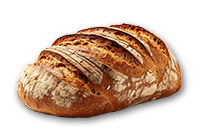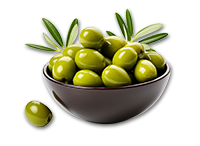Israelites at the time of Christ ate frugally. Food was a lot more scarce and less convenient than it is today. Available items changed with the seasons and all items were made from scratch.

Bread was the essential, basic food. So basic was it that in Hebrew "to eat bread" and "to have a meal" in the same thing. Bread was treated with great respect and many rules existed to preserve that reverence. Any crumbs of over the size of an olive were expected to be gathered, and never simply discarded. Bread was never cut, but always broken. Poor people ate barley bread while the well to do enjoyed bread of wheat.
Grains were ground between two millstones, almost always by women in the home. From this the flower and then the dough was made and worked in needing troughs. To make the heavy barley bread rise, women use very strong millets, and barley yeast. The loaves were usually made round, such that one spoke of a "round of bread."
Cows milk was rare, and was not preferred to the milk of ewe lambs and of goats. Since milk tended to spoil quickly, cheese making was very common.
Honey was the sweetener that was used for most purposes as cane sugar was unknown. The source of honey was bees, which were colonized as is done today. Saps from various trees and the thickened juice of grapes were also common sweeteners. Palestine produced enough honey to export it to other regions.
Fruit had an important place in the people's diet. There were many melons and figs as well as dates, pomegranates and blackberries. Because of its abundance it was often exported. Nuts were also in abundance, especially walnuts, almonds, and pistachios. They were commonly roasted before serving.

Ancient Jews enjoyed their food strongly seasoned. Salt, obtained from the Dead Sea area, was used as seasoning and to preserve certain foods. Other common spices included mustard, capers, cumin, rue, saffron, coriander, mint, dill, rosemary and garlic. Pepper and cinnamon were scarce and expensive, both requiring import from the Far East.
Butter was rare in use while olive oil was much more common. So abundant were olives and olive oil, that some was exported. Olives were eaten directly and also had the oil pressed from them at oil presses in the homes. Olive oil was highly prized, and many passages in the Bible hold it up it's a symbol of strength and health.
The diet of ordinary people included a great many vegetables, with lentils and beans being the most widely enjoyed. Cucumbers were available and used in many meals as were onions.
Far less meat was consumed than is today. Meat was a luxury food that only the wealthy could have with regularity. Poor people rarely slaughtered an animal for their own eating, except when there was a family feast. When such a feast approached, an older animal was chosen, and fattened up by feeding it grain. Therefore such an animal spent its last months eating well and working little so that its muscles were softer, and fattier.
Lambs and goats provided the most commonly used meat, and very occasionally a calf. Chickens were scarce and common folk more often enjoyed pigeons and turtledoves which were cheap. Wild game was prized, but only available to the wealthy. Deer and gazelle were considered kingly dishes, and peacock was considered a great delicacy.
Pork was absolutely forbidden along with rabbit and any meat with blood still in it. Meat had to be carefully drained of all blood, as it was believed that life was in the blood, (and that life belonged to God).

For most common people, fish was more important than meat. Bread with fish was a common meal, as illustrated by the miracle of The loaves and the fishes. A breakfast of bread and fish was depicted at the lakeside in Galilee where the risen Christ prepared fish for his apostles over a charcoal fire. The Sea of Galilee had great quantities of fish while other types were gotten from the Mediterranean Sea. Since fish soon turned bad, it was often salted to preserve it.
One of the most surprising forms of food was the locust. An ancient Jewish document claims that there were 800 different kinds of edible locust. They were often cooked rapidly in salt water and had a shrimp like taste and color. Usually their head and legs were taken off and sometimes they were dried in the sun. After being dried, they were ground down to a powder that tasted rather bitter and was mixed with flour to make a much-prized bitter biscuit.

People drank water when it was pure, and spring water was highly preferred over well water. Milk, and vinegar diluted with water were also drunk. Juice from pomegranates or dates was used and a kind of light beer was made from barley and millets.
Wine was a very important staple, with legend saying that God himself first showed Noah how it was made. Vineyards and grapes were in abundance in ancient Israel. Although grapes were occasionally eaten, most of them were used in making wine.
The vine was a symbol for Israel in the Scriptures. Since wine was considered sacred, it had to be kosher, (made only by Jewish hands). Only red wine that was consumed in biblical times. It was always spoken of as having the color of blood, and thus it was a deep red or purple color. Wine was kept either in tall jars or in wineskins made out of goats hide with wooden stoppers. It was filtered before it was consumed. Then as now, there were different qualities of wine, with some considered inferior and some more desirable. It was drunk out of metal goblets or earthenware mugs since glass was scarce and expensive.